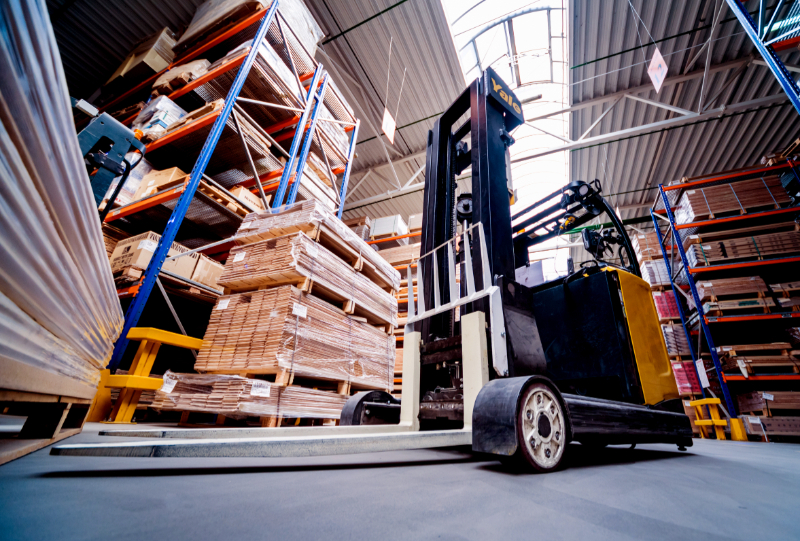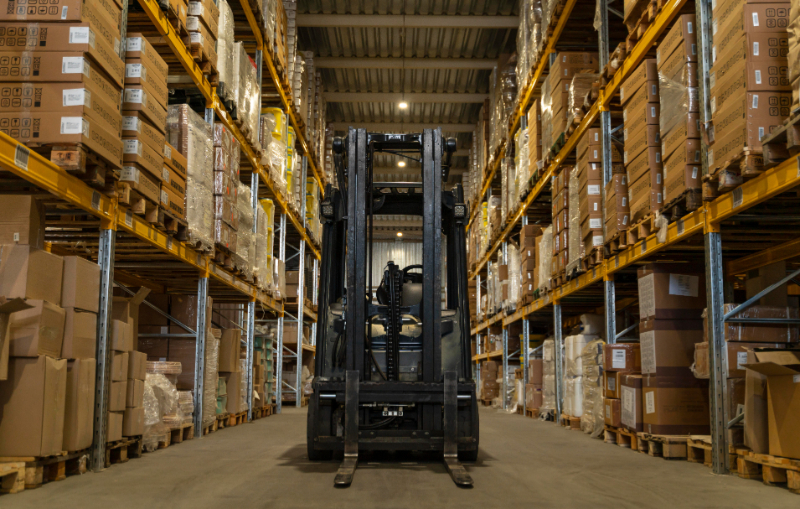Do you need to find out How To Operate A Forklift Safely in the UK? Aire & Worth Valley Training Services Ltd offer forklift truck training in Yorkshire, Lancashire, Cumbria, Greater Manchester, Merseyside, and Northumberland. We look at tips for Operating A Forklift Safely from Proper Forklift Training through to Lifting Loads Responsibly.
How To Operate A Forklift Safely UK
Operating a forklift truck can be a challenging and demanding task. Therefore forklift truck operation requires careful consideration and attention to safety.
In the UK, it is a legal requirement for anyone operating a forklift to have completed specific training and hold a valid certification. This is to ensure that individuals have the knowledge and skills necessary to operate the equipment safely and efficiently.
In this guide, we will provide an overview of the key considerations and best practices for operating a forklift truck safely in the UK. Whether you are new to forklift operation or seeking to refresh your knowledge. This guide will provide you with the information you need to stay safe on the job.
Why Forklift Training Is So Important?
Forklifts are crucial pieces of machinery used to move heavy loads from one point to another. However, they can be dangerous if operated improperly. In the UK, forklift truck accidents cause around 1,000 serious injuries or fatalities every year. Poor maintenance, wear and tear, and a lack of driver training are all contributing factors to these incidents
Employers and warehouse managers have a responsibility to ensure that their workers are fully trained to operate forklifts safely. Neglecting this duty can result in severe losses for a company and even legal liability for its management.
Operating a forklift is more complicated than most people realize. Allowing untrained personnel to use these machines can be extremely hazardous. Therefore, employers should prioritize forklift training. This is to ensure workplace safety and protect their staff and equipment.

Operating A Forklift Safely
Maintaining a safe workplace is crucial for any business. One way to achieve this is by maximizing equipment and staff performance. By implementing practical tips and strategies, companies can improve safety while increasing efficiency and productivity.
Here are some essential tips to ensure workplace safety and optimize equipment and staff performance. Here are some tips to ensure workplace safety and maximize equipment and staff performance:
Checks Before You Start
Before starting the forklift, adjust mirrors, seat, and controls for the individual operator, and ensure the seatbelt is fastened.
Proper Forklift Training
Ensure proper training for your team to operate equipment safely and legally, fulfilling your legal obligations as an employer.
Safe Loading
Use safe loading procedures, tilting the load slightly back toward the vehicle. Keep the forks low while moving, and properly securing the load with pallets or skids, ropes, straps, or bindings.
Maintaining A Clear View
Maintain good visibility by positioning the load low and keeping it in sight. Operate the forklift in reverse if necessary, and stopping if weather affects visibility.
Travelling On An Incline
Follow good working practices when traveling on ramps or inclines with a loaded forklift. Move in the forward direction while traveling uphill and backward. When traveling downhill, stay away from the edge of the ramp, and not exceeding the manufacturer's recommendations.
Be Aware Of Your Surroundings
Follow site rules, speed limits, and safety guidelines while operating the forklift. Drive only on designated roads or paths, staying below 10 mph, avoiding low ceilings, doorways, loading bays, and exclusion zones.
Safe Work Wear
Provide personal protective clothing to operators to ensure their safety when using a forklift. This includes hard hats, safety shoes, hi-vis jackets, and tight-fitting clothing.
Avoid Hazards
Avoid hazards such as bumps, slippery ground, uneven surfaces, loose materials or objects. Maintain a safe distance from other operatives and vehicles while staying alert to surroundings.
Safety Inspections
Conduct regular safety inspections before each use. This includes checking brakes, steering, controls, warning devices, mast, and tires. Immediately take the vehicle out of action if there are any problems or faults and record all inspections and actions taken.
Park Safely
At the end of the shift, park the forklift safely in the designated area. Never change mid-shift or in an unauthorized zone without checking the vehicle. Always check and adjust controls, seat, and mirrors in a safe and designated area.
Safely Lifting a Load
When it comes to lifting loads with a forklift truck, there are several crucial considerations that operators must keep in mind. This is important to ensure safe and efficient operation.
Some of the most important factors to consider include assessing the load, understanding the weight and lift capacity, using appropriate lifting aids, inserting the forks correctly, avoiding lifting people, keeping pedestrians at a safe distance, following load capacity guidelines, and lifting loads responsibly. By taking these considerations seriously and implementing appropriate safety measures, forklift operators can help to prevent accidents and injuries in the workplace.
Improving Forklift Safety Of The Workplace
Forklifts are a vital tool for businesses involved in materials handling. Forklift trucks allow for safe lifting, transporting, and moving of loads, while also saving time and money.
The use of forklifts can pose significant risks to both operators and bystanders. Therefore there is a need for proper consideration of all risks before commissioning a forklift on your premises.
It's essential that each forklift truck operator is certified to operate the equipment to ensure safety. Forklift training not only improves workplace safety but also boosts productivity and efficiency. Fully trained forklift truck operators have a better understanding of the equipment.
This includes design, capabilities, and limitations, leading to improved performance. Additionally, forklift training can help reduce stress levels for operators by teaching coping mechanisms and techniques to handle stress in the workplace.

What Are Pedestrian Considerations When Using A Forklift
Pedestrian safety is a crucial consideration when using a forklift, as forklifts can pose a significant danger to people who are on foot in the work area. Some pedestrian considerations when using a forklift include:
Establishing designated pedestrian walkways and areas where forklifts are not allowed.
Making sure that pedestrians are aware of the presence of forklifts and the potential hazards they pose.
Providing high-visibility clothing for pedestrians and requiring them to wear it in areas where forklifts are operating.
Installing mirrors or other devices to improve visibility for forklift operators and reduce the risk of collisions with pedestrians.
Ensuring that forklift operators are trained to be aware of pedestrians and to always drive at a safe speed.
Never allowing pedestrians to ride on the forklift, even as a passenger.
Prohibiting pedestrians from walking under or near loads being carried by the forklift.
By implementing these and other safety measures, companies can help reduce the risk of accidents and injuries involving forklifts and pedestrians in the workplace.
Other Considerations for Lifting Loads with a Forklift Truck:
Assess The Load
Before lifting any load, ensure that you assess it thoroughly, taking into account its weight, size, load centre, and its condition, including the pallet it's on. Avoid lifting loads that are in poor condition or not secured properly.
Understand the load weights and lift capacity of your forklift truck. Remember that the lift capacity decreases as the load centre moves further away from the mast or as the load is lifted to a greater height.
Load Weights And Lift Capacity
Lifting Aids
Take into account any lifting aids, such as side shift or slings, that may affect the lift capacity.
Make sure that the forks are correctly inserted before starting the lift. Do not attempt to lift anybody on the forks or a pallet on the forks.
Insert Forks Correctly
Watch For Pedestrians
Keep pedestrians at a safe distance and never allow them to walk under a raised load.
Follow the load capacity strictly and never add an additional counterweight to the rear of the vehicle to increase the load capacity.
Do Not Lift Anybody On The Forks
Lift Loads Responsibly
Lift loads responsibly and avoid using two forklift trucks to lift one load, unless a competent person has made a careful plan and assessed the risk involved.
Forklift Truck Training in Yorkshire, Lancashire, Cumbria, Greater Manchester, Merseyside, and Northumberland
We offer on site ITSSAR Accredited workplace transport training in Keighley, Bradford, Skipton indeed all across West Yorkshire, Lancashire and the north of England in particular but are happy to serve our customers were ever they need us in the UK. We have been providing ITSSAR accredited on-site training courses since 2003.
Our services include: forklift training, materials handling and access equipment training. Get in touch to see how our courses can help keep you safe in the workplace.


